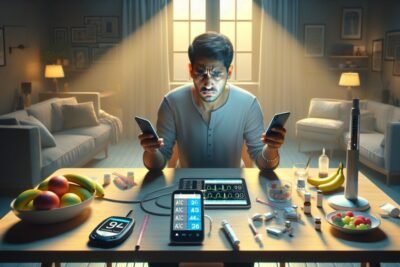
Managing diabetes requires constant vigilance, and technology plays a critical role in monitoring blood sugar levels. Flash glucose monitors and continuous glucose monitors (CGM) have transformed diabetes care by offering an easier and less invasive way to check glucose levels.
Individuals living with diabetes can now monitor their condition in real-time, gaining invaluable insights into their glucose trends. This guide will compare these two innovative devices, helping you to understand their functions, benefits, and key differences.
What you\'ll find in this article?
- What Is a Flash Glucose Monitor?
- How Does Flash Glucose Monitoring Work?
- What Is the Difference Between a Flash Glucose Monitor and a Continuous Glucose Monitor?
- How Do I Get a Flash Glucose Monitor or CGM?
- Pros and Cons of Using a Flash Glucose Monitor or CGM
- Learning to Use Your CGM or FreeStyle Libre
- Further Insights on Flash Glucose Monitoring (Freestyle Libre) and CGM
- Glucose flash monitor
What Is a Flash Glucose Monitor?
A flash glucose monitor is a device that allows people with diabetes to check their glucose levels by scanning a sensor usually worn on the upper arm. One of the most well-known flash glucose monitors is the FreeStyle Libre. The sensor, which is applied to the skin, uses a tiny filament to measure glucose in the interstitial fluid. This system does not provide continuous data, but rather glucose readings each time the user scans the sensor.
Flash glucose monitoring systems are particularly beneficial for those who require frequent monitoring. They provide a convenient and painless alternative to traditional finger-prick tests. With a quick scan, users can immediately access current glucose levels as well as 8-hour historical data.
The adoption of flash glucose monitoring technology has been a game-changer for many, offering freedom from the constant disruptions and discomfort associated with regular finger pricks. It also gives users the ability to track their glucose patterns over time, which is essential for effective diabetes management.












How Does Flash Glucose Monitoring Work?
Flash glucose monitors work by using a small sensor that continuously measures glucose levels in the interstitial fluid beneath the skin. The sensor is applied to the back of the upper arm and can be worn for up to 14 days. To read glucose data, the user simply waves a handheld reader or smartphone over the sensor.
This innovative technology captures glucose data every minute and stores readings at 15-minute intervals. This means that when the user scans the sensor, they not only get the current level but also a detailed graph showing fluctuations over the past 8 hours.
With advancements in technology, some flash glucose monitors can now share data with a mobile app, allowing users to store, analyze, and share their glucose data with their healthcare team.
Moreover, by providing trends and patterns, flash glucose monitors can help users and healthcare providers make more informed decisions regarding diet, exercise, and medication, leading to better overall diabetes management.
What Is the Difference Between a Flash Glucose Monitor and a Continuous Glucose Monitor?
The core difference between flash glucose monitors and continuous glucose monitors (CGM) lies in how data is collected and transmitted. While both systems use a sensor placed on the body to measure glucose levels, CGM systems transmit data automatically and continuously to a dedicated receiver or smartphone app, providing real-time alerts and trends.
CGMs can sound alarms if glucose levels are too high or too low, allowing users to take immediate action. They can also be integrated with insulin pumps to adjust insulin delivery automatically, a significant benefit for those with type 1 diabetes.
Flash glucose monitors, on the other hand, require the user to scan the sensor to obtain glucose readings. While CGMs provide a more constant stream of data, flash glucose monitors offer a less complex and often more affordable option for monitoring glucose levels.
How Do I Get a Flash Glucose Monitor or CGM?
Obtaining a flash glucose monitor or CGM typically starts with a consultation with a healthcare provider. They can assess your specific needs and determine which system would be best suited for you.
In the UK, the NHS may cover the cost of these devices for eligible individuals. Criteria for eligibility include frequent hypoglycemia, a commitment to use the system most of the time, and attending a training course to understand how to use the device effectively.
For those who do not meet the NHS criteria or live outside the UK, flash glucose monitors and CGMs are also available for self-funding. It's crucial to consider ongoing costs, such as sensor replacements and possibly the cost of the reader if not using a compatible smartphone.
Choosing the right glucose monitoring system is a personal decision, and it's important to weigh the potential benefits against the costs and requirements for use.
Pros and Cons of Using a Flash Glucose Monitor or CGM
Like any technology, flash glucose monitors and CGMs have their advantages and disadvantages. Here are a few to consider:
- Pros:
- Reduced need for finger-prick testing
- Real-time glucose level tracking
- Trend data helps to inform treatment decisions
- Integration with smartphones and insulin pumps
- Increased convenience and discretion
- Cons:
- Cost can be a barrier for some individuals
- Requires regular sensor replacement
- Potential for technical issues or inaccuracies
- May still require occasional finger-prick tests for calibration or verification
- Some individuals may experience discomfort or skin reactions
Ultimately, the decision to use a flash glucose monitor or CGM should be made in consultation with a healthcare provider, taking into consideration individual health needs, lifestyle, and the potential impact on diabetes management.
Learning to Use Your CGM or FreeStyle Libre
Adopting a new diabetes management tool like a CGM or a FreeStyle Libre system requires a learning curve. It is important to undergo proper training, either through your healthcare provider or via resources provided by the manufacturer.
Understanding how to apply, calitate, and interpret data from your device is crucial. Moreover, recognizing how to respond to the data and use it to adjust your diabetes management plan is key to getting the most out of the technology.
Remember that while these devices provide valuable information, they are tools to assist you in managing your diabetes. They should be used as part of a comprehensive diabetes care plan that includes diet, exercise, medication management, and regular check-ups with your healthcare provider.
Now that we've covered the basics of flash glucose monitors and CGMs, let's delve into some further questions people often have about these devices.
Further Insights on Flash Glucose Monitoring (Freestyle Libre) and CGM
What Is the Difference Between Flash Glucose Monitoring and CGM?
The main difference is in the way the glucose data is accessed and reported. Flash glucose monitoring requires the user to actively scan the sensor to retrieve glucose readings, while CGM provides continuous, automatic updates directly to a receiver or smartphone.
CGM systems offer additional features such as predictive alerts that can warn of impending high or low glucose levels, while flash glucose monitors provide a snapshot of current levels and trend data when scanned.
Is FreeStyle Libre Flash or Continuous?
The FreeStyle Libre system is considered a flash glucose monitor. While it does record glucose levels continuously, the data must be manually scanned by the user to be accessed, distinguishing it from a traditional CGM system which sends data automatically.
What Is Continuous and Flash Glucose Monitoring?
Continuous and flash glucose monitoring are both methods of tracking glucose levels without the need for regular finger-prick blood tests. Continuous monitoring provides real-time, automatic glucose readings, while flash monitoring provides readings on-demand with a manual scan.
Is a FreeStyle Libre Sensor a CGM?
No, the FreeStyle Libre sensor is not classified as a CGM because it does not provide automatic real-time glucose readings. It is a flash glucose monitor that records glucose data continuously but requires the user to scan the sensor for information.
To further enhance your understanding of these devices, let's watch a brief video that explains how flash glucose monitors and continuous glucose monitors work, and their role in diabetes management.
Embracing new technology can be a significant step forward in managing diabetes. With proper guidance and understanding, flash glucose monitors and CGMs can offer a new level of control and freedom for those living with this condition.
Glucose flash monitor
Flash glucose monitors, such as the Freestyle Libre, offer a convenient way for individuals with diabetes to track their glucose levels. These devices use a small sensor inserted under the skin to measure glucose concentrations in the interstitial fluid.
One of the key benefits of flash glucose monitoring is the real-time data it provides. Users can scan the sensor with a reader or smartphone to view their current glucose level and trends, allowing for timely adjustments in their management strategies.
Unlike traditional glucose meters, flash monitors do not require frequent finger pricks. This feature enhances user comfort and encourages more consistent monitoring of glucose levels throughout the day, which is critical for effective diabetes management.
Additionally, flash glucose monitors can help users identify patterns and fluctuations in their glucose levels. This information can be invaluable for making informed decisions about diet, exercise, and medication, ultimately leading to better overall health outcomes.
Overall, flash glucose monitoring represents a significant advancement in diabetes care, providing users with greater flexibility and insight into their glucose management. This technology continues to evolve, offering new features and improved accuracy to enhance user experience and health management.
✨ Other articles you might be interested in:
- Omnipod 5 Approved for Integration with FreeStyle Libre 2 Plus Sensor
- James E's Comprehensive Review of FreeStyle Libre 2 for Diabetes Management
- Understanding Time in Range for Effective Diabetes Management
- Essential Freestyle Libre2 troubleshooting information for users
- Exploring Smart Insulin Pens: Functionality and User Experiences






